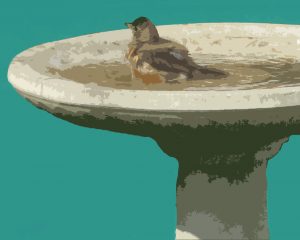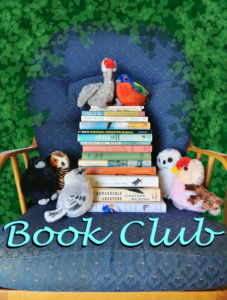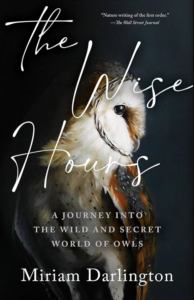 As most of you know by now, six major avenues to making your yard (or other space) more bird friendly are to provide food, water, shelter, plus protection from toxins, from predators, and from window strikes. Water is perhaps the most important and beneficial of these needs, and one of the least costly, but one often overlooked here in the northwest; we always seem to have an abundance of water, so many bird lovers believe we don’t need to set out water for our local birds. That’s an unfortunate misconception, for our birds do need reliable water sources, especially during the summer and early fall. In addition, having a water source is probably the single best way to increase the variety of species frequenting your space, including species that feeders generally don’t attract—birds that don’t like seeds or are primarily insectivorous.
As most of you know by now, six major avenues to making your yard (or other space) more bird friendly are to provide food, water, shelter, plus protection from toxins, from predators, and from window strikes. Water is perhaps the most important and beneficial of these needs, and one of the least costly, but one often overlooked here in the northwest; we always seem to have an abundance of water, so many bird lovers believe we don’t need to set out water for our local birds. That’s an unfortunate misconception, for our birds do need reliable water sources, especially during the summer and early fall. In addition, having a water source is probably the single best way to increase the variety of species frequenting your space, including species that feeders generally don’t attract—birds that don’t like seeds or are primarily insectivorous.
Birds, like most other terrestrial animals, need to drink to maintain adequate fluid levels in their bodies. Hatchlings, especially, need a lot of water, and frequently don’t get enough from their food, so parents must carry water to them, making numerous trips daily from water sources to the nest. To increase the water content of food, some birds, such as crows and ravens, commonly soak or “wash” food before feeding it to their young or eating it themselves. (Another reason that water attracts them.)
While everyone understands the need to consume water, we mammals may never have thought about the differences between avian and mammalian drinking. Since birds don’t sweat, they generally need to drink less water than mammals. But they do lose water when breathing, especially when panting to lose heat, and metabolic processes also use up water supplies. The mechanics of ingesting water also differ: with their soft, mobile lips and cheeks, mammals can suck up water and swallow it, but except for pigeons (who can suck up water), birds use one of two techniques. Most fill their beaks with water and then tilt their heads up so the water runs passively down their throats; those that frequently fly over water, such as swallows, scoop it up on the wing during a low pass.
Birds also need water for bathing; they bathe year-round, and during the summer may do so several times a day. Bathing seems to make preening more effective. Preening refers to the movements birds make when cleaning their feathers to remove dirt and parasites, distribute oils, and align the feathers and their barbs. Preening behaviors are common, and most birds preen several times a day. Most birds have a special gland, the preening or uropygial gland, that produces an oily, waxy substance that they spread as they preen; a few birds such as pigeons, owls, and raptors lack this gland and instead have special feathers that crumble into a powder that serves many of the functions of preening oil. Such preening powder doesn’t convey the same waterproofing benefits as oil, so birds that produce it are less likely to bathe in water than other birds. Research by Brilot and colleagues has shown that preening is more effective when preceded by bathing: birds who bathe before they preen are more agile when flying through an obstacle course than those who don’t bathe, and birds seem to be aware of this clumsiness: non-bathing birds are more reluctant to approach food in the presence of predator noises than cleaner birds, presumably because at some level they have less faith in their ability to escape danger.
Water bathing also helps birds keep cool. When they bathe, they lift their feathers so the water contacts their skin, and adding ice cubes to a bath makes the water a better cooling agent. Birds such as woodpeckers and nuthatches will fluff their feathers in the rain to expose their skin to the drizzle. In dry seasons, you can provide “rain” by setting up a mister, which may be attached to a water bath or be free-floating.
Bird baths aren’t all created equal. The best are shallow and have a ramp, or contain stones or pebbles so that birds can choose the depth at which to stand. Wet plastic, ceramic or metal can be slippery, so scuffing the surface or putting sand on it helps the birds have sure footing. Water baths must be cleaned and sanitized weekly with a 1:10 solution of bleach and water. If predators are a problem in your yard, make sure the baths are raised on a pedestal and are placed where there is little concealment for cats and other hunters.
Bathing is important enough to birds that some even take dust baths, some because they lack standing water puddles or preening oil, but many others— such as California quail, pheasants, thrushes, larks and wrens—prefer dust baths even when water is available. In fact, wrens and House Sparrows will follow up a water bath by immediately taking a dust bath. To attract birds and watch dust-bathing, provide a patch of bare, clean, very dry, fine-grained soil, preferably in a sunny spot, surrounded by brick or stones to help keep the loose soil in place. And as with water baths, raise the dust-bath off the ground and don’t place it too near shrubs that might conceal a predator.
Let me know how well your new bird baths work and what new species you attract! I can be reached at kgdolgin@owu.edu.







